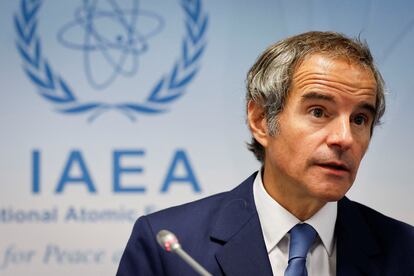UN nuclear watchdog expresses ‘extreme concern’ over safety of Zaporizhzhia power plant
The facility has been occupied by Russian forces for two years with barely any power supply to cool the reactors. The director of the IAEA is expected to meet with Vladimir Putin on Tuesday

Beyond the periodic warnings from Russian President Vladimir Putin about resorting to atomic missiles, Russia’s invasion of Ukraine has provoked a much more tangible nuclear threat in a country that suffered one of the biggest disasters in history — Chernobyl — in 1986. The Zaporizhzhia nuclear power plant, occupied by Russian troops on March 4, 2022, is now in “an unprecedented situation,” the director general of the International Atomic Energy Agency (IAEA), Rafael Grossi, said Friday, stating that he is “extremely concerned” about safety at the center.
Two years ago, the Russian army bombed and seized the facility, to the bewilderment of half the world. Since then, Zaporizhzhia has suffered eight total blackouts that have forced its staff to use diesel generators to cool its six reactors. Over the last two weeks, it has relied on only one of the 10 power lines that supplied it before it was occupied, with no other available backup power source.
As the war enters its third year, the plant’s precarious operational status remains a source of extreme concern. Since the outbreak of hostilities, Grossi has paid nine visits to Ukraine to monitor it. The U.N. atomic watchdog maintains a team of inspectors at the facility who report on explosions and military activity around the site, located near the city of Enerhodar on the south bank of the Dnieper River, where the sound of air raid sirens is constant. The permanent power shortage affects not only the cooling capacity of the reactors, but also “other essential nuclear safety and security functions,” according to the agency.
The fact that such a facility continues to operate under these conditions is, in Grossi’s words, “an unprecedented situation” in the history of nuclear power and “clearly not sustainable.” “I remain extremely concerned about nuclear safety and security at the plant,” he added. According to an IAEA statement, for the past two weeks the plant has relied on a single 750-kilovolt line to receive the power supply it needs, without any backup power in case that line fails. Agency inspectors have said they expect another 330-kilovolt line to come online in the next few days. “Even if one back-up line becomes available again, it is far from sufficient,” Grossi warned. Before the invasion, the plant had four 750-kilovolt and six 330-kilovolt power lines to guarantee its operation.

Grossi, who met with Ukrainian President Volodymyr Zelenskiy in February to discuss the situation at the country’s nuclear plants, is scheduled to travel to Russia on Tuesday, where he is likely to meet Putin to discuss the situation at the Zaporizhzhia facility.
Peter Kotin, the president of the Ukrainian state nuclear energy company, Energoatom, said Monday that the anniversary of the seizure of the plant comes at a particularly sensitive time, because the six-year deadline for the use of nuclear fuel is about to expire. Also, he says, the Russians are not allowing qualified Ukrainians to work at the plant, replacing them with poorly trained employees from Russian facilities. “Will this date mark the beginning of the countdown to tragic and catastrophic events for all mankind?” he asks in an article published on the second anniversary of the occupation of the Zaporizhzhia plant. He replies to his own question: “The probability of this happening is higher than ever.”
Of seven criteria, six are compromised
In two years of Russian control, the nearest Zaporizhzhia came to disaster was on June 6 last year, when Kremlin troops blew up the dam at the Nova Kakhovka hydroelectric power plant (93 miles to the southwest), causing the reservoir from which the plant is fed to empty and forcing the refilling of the pool used to cool the reactors. “Discussions continue on the need to address the consequences of the flooding in Kherson province,” the IAEA chief said Monday, referring to the possible contamination spread by the catastrophic flooding caused by the attack downstream at the mouth of the Dnieper.
With a severe shortage of personnel — some of the Ukrainian employees left their posts after the outbreak of the war — and supply not assured, six of the seven criteria established by the IAEA to ensure safety at the plant are compromised according to the inspectors: the full operation of its safety systems, the safety and security of its personnel, safe energy supply, protection of the logistics and transport supply chain, the establishment of effective radiation monitoring systems inside and outside the plant, and communication with the regulator, Energoatom.
The only commitment to date that has been respected is the physical integrity of the facilities, despite the Russian bombing during its capture eight days after the start of the invasion, which according to Kyiv provoked a fire that claimed the lives of several employees. After the seizure of the nuclear plant, Ukraine set up a crisis mechanism in case of an atomic accident that implies the mandatory evacuation of 300,000 people in the regions of Dnipropetrovsk, Zaporizhzhia, Kherson, and Mykolaiv. The authorities stage periodical drills in the area to prepare for such an eventuality.
Sign up for our weekly newsletter to get more English-language news coverage from EL PAÍS USA Edition









































